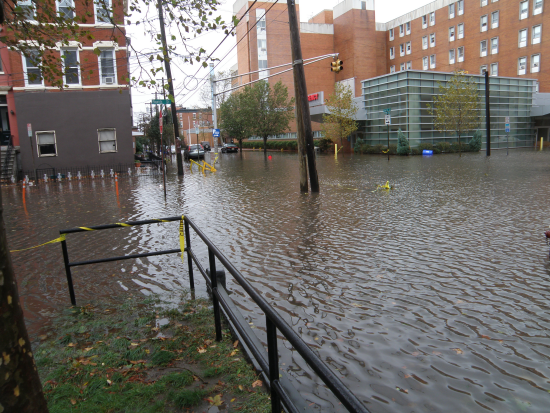By Ron Hine | FBW | November 20, 2012
FBW is providing this 12-Point Plan in an attempt to inform the debate about what can be done to protect communities such as Hoboken where half of the town flooded during Hurricane Sandy. FBW will pursue this plan for Hoboken, in cooperation with the government, experts and local citizens, in an effort to diminish the impact of the next, inevitable storm.
- Map It. Show where the flood waters breached the bulkheads and shorelines during Hurricane Sandy via satellite or other images. Map the flooding at peak levels. Remedies need to be based on expert analysis of this data.
- Make prevention the priority. In the U.S., disaster relief takes precedence over disaster avoidance. Learn from the Dutch who focus most of their resources on preventing future disasters.
- Work with nature not against it. Restore wetlands, make room for rivers to rise and preserve floodplains. Build underground parks that can take in floodwaters.
- Trickle down eco-nomics. Require green roofs and permeable surfaces, including permeable streets and sidewalks with catchment basins.
- Raise the revetments. Build bulkheads, seawalls & sea gates to appropriate levels based on data from Hurricane Sandy.
- Utilize soft infrastructure. Rebuild marshes and other natural barriers, like oyster reefs, that provide a buffer to storms. Create artificial reefs that can do the same.
- Eliminate combined sewer systems. Separate lines for sewage and stormwater. Ensure flood gates and pumping stations work even during a power outage.
- Increase setbacks from rivers and oceans for private development. Ban non-water dependent development of piers and platforms. Create public parkland at water’s edge designed to withstand storms.
- Batten down the hatches. Provide for sealing entrances to subways and tunnels in flood zones. Elevate entrances to subways.
- Develop microgrids. Smaller electric grids with their own source of power such as fuel cells, wind or solar can provide service when main grid shuts down. Ensure that power systems are flood-proof.
- Decrease global warming. With melting ice caps and rising sea levels, it is time to get serious about ending our reliance on fossil fuels and emitting greenhouse gases. Dirty energy is a reason why storms are stronger, floods more destructive and weather catastrophes more frequent.
- Build above base flood elevation. Municipalities must strictly enforce building codes using the new, soon to be released, FEMA flood maps; join the National Flood Insurance Program’s Community Rating System; and revise permitted uses and other zoning restrictions in flood zones.
Please give us your ideas and feedback. This list is a working document and we will flesh out the details as we move forward.
Related links
Dutch Dialogues: a model for Hoboken
Flood insurance rates will skyrocket
Monarch Towers now in FEMA’s Coastal High Hazard Flood Zone
79% of Hoboken falls into FEMA’s flood zone
Post Sandy: After repairing the damage, then what?
The morning after Sandy: Hoboken’s waterfront parks
Sandy, the day after – Hoboken waterfront pics
The Long Slip Canal and protecting Hoboken from the next surge
Post Sandy Resources
After Sandy: Leadership Ideas for a Changing Waterfront – MWA
Philip Orton, research scientist at Stevens Institute specializing in fluid dynamics (#1)
Lessons for U.S. From a Flood-Prone Land (#2 & #3)
Big Projects, Big Problems, So Think Small (#3 & #9)
Leveraging the Landscape to Manage Water (#4)
5 Ideas That Could Have Prevented Flooding in New York (#5 & #9)
New York can be a vibrant Venice as sea level now rises (#6)
MoMA’s Rising Currents exhibit (#6)
High Tide on Main Street: Rising Sea Level and the Coming Coastal Crisis (#8)
Microgrid Technology Faces Its 1st Big Test (#10)
Climate Realty Project (#11)
FEMA Flood Hazard Mapping (#12)

